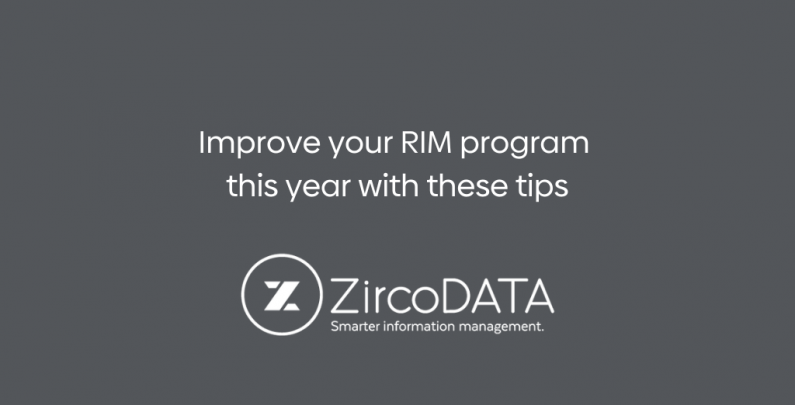
Improve your RIM program this year with these tips
To kick off 2023, we are sharing RIM (Records and Information Management) tips to ensure your information is secure, compliant, and easy to locate into the future.
What is a RIM Program?
Records Information Management (RIM) is a function that involves the business information management of all records at every stage of their lifespan from creation to archiving or destruction in accordance with the applicable regulations.
Businesses are producing more content while attempting to comply with more regulations due to the escalating regulatory environment and the explosive growth of information. In addition to there being more information, formats used to create, manage, and store that information are also evolving. The RIM program no longer just applies to conventional physical and electronic documents. Additionally, RIM compliance demands that it include everything from file cabinets to file shares, the cloud, and mobile devices, as well as email, instant chats, and social media.
Organizations that violate regulations run the danger of paying significant fines, being sued, and even having their information compromised, which can harm their reputation and decrease shareholder value. The only way to proactively manage and safeguard your corporate information while guaranteeing compliance is with a thorough RIM strategy. The five essential areas for assessing and enhancing your RIM policy are listed below.
What is Information Governance (IG)?
Information governance refers to all the policies, procedures, and frameworks that an organisation must follow when creating, managing, and destroying its information. Unlike a RIM program, which just tackles the lifetime of a document, an IG program takes a more comprehensive approach to make sure that all information created is in line with your organization’s goals. All workers and departments within the firm must be aware of and adhere to the proper procedures for producing and managing business information for IG to be effective.
What function is Responsible for the Information Management Process?
A RIM policy can only be effective if all of the organization’s employees support it. This comprises workers at all corporate levels and executive board or leadership team members. Choose a person or group of people who can be in charge of assessing and enhancing your RIM program. This might include members from every division of the business, a records manager, or a RIM partner who can assist you with an information audit and the development of an all-encompassing plan for generating, maintaining, and erasing your information.
A RIM committee can also assist firms in maintaining RIM compliance by keeping abreast of the most recent laws and guidelines, responding to fresh problems or difficulties as they appear, and aiding in the ongoing instruction and training of staff in RIM best practices.
Plan and Coordinate a Records Retention Schedule
Employees are informed via a records retention schedule of how long to keep each type of document in order to comply with RIM. Retention schedules are determined by an organization’s operational needs and legal and regulatory constraints.
For fear of one day needing a file they deleted, many firms keep papers on file indefinitely. However, storing information past the time it should be kept is costly and dangerous. Businesses lose time and money keeping old records around for too long, and if they are revealed in a data breach or during legal proceedings, they could face liabilities. Retention schedules ensure compliance while saving time and money and assisting organisations in better organising, managing, locating, and retrieving their information.
If there are no audits or litigation holds at the conclusion of the retention period, all material should be securely erased. A careless demolition schedule won’t do. Establish a systematic process to ensure that all data that has satisfied the standards for retention is destroyed as quickly as practicable.
Write Your RIM Policy Down
As previously stated, an organization’s RIM policy should be understood by every employee. Clarity and consistency are essential. Create a company-wide policy that explains in detail the steps that each employee must take to manage a document’s lifetime, from creation to sharing and deletion. The following should be covered by this policy:
- Employee responsibilities and roles
- Documents’ lifecycle
- Information ownership
- Audits
- Law holds
- Controls over sharing and access
- Keeping records current
- Regular RIM training and best practices
All staff members should have easy access to and understanding of the RIM policy throughout the company. The provision of continuing training and education on records management and information security may benefit from the strategic use of HR.
Share Digital Files with Caution
Employees should be able to identify and access the information they need, when and where they need it, whether for an audit, legal considerations, or business assistance. Additionally, they must be able to provide that information upon request to outside auditors. Despite the dangers of emailing sensitive material, which include the possibility of it being hacked, printed, or copied, to mention a few. Employees require a safe method of sharing information while also keeping track of who is accessing it and how.
Consult a document management expert for help with your RIM program
Audits and other company chores are made simple with the aid of a digital document management solution. Find more about our solutions here.

Recent Comments